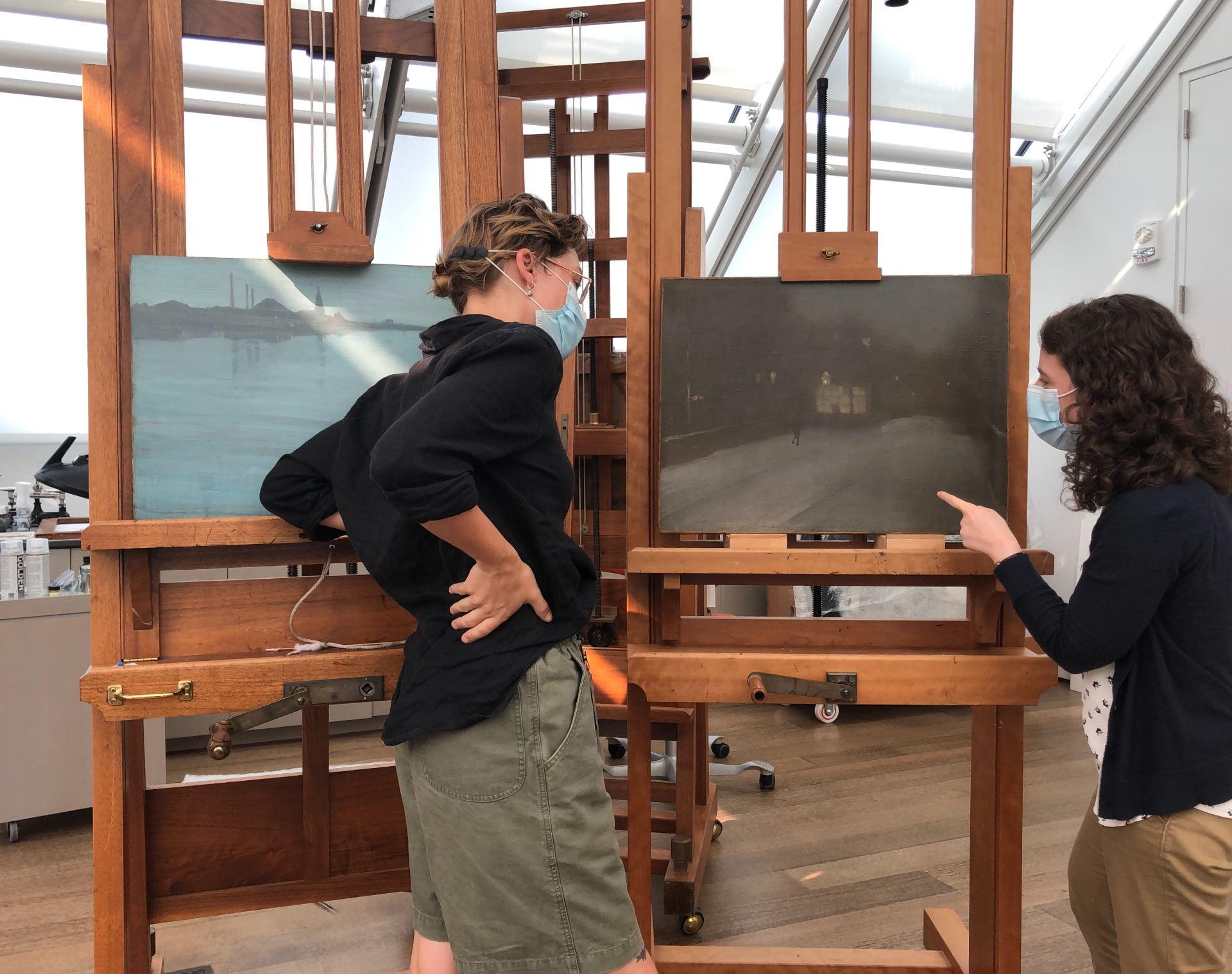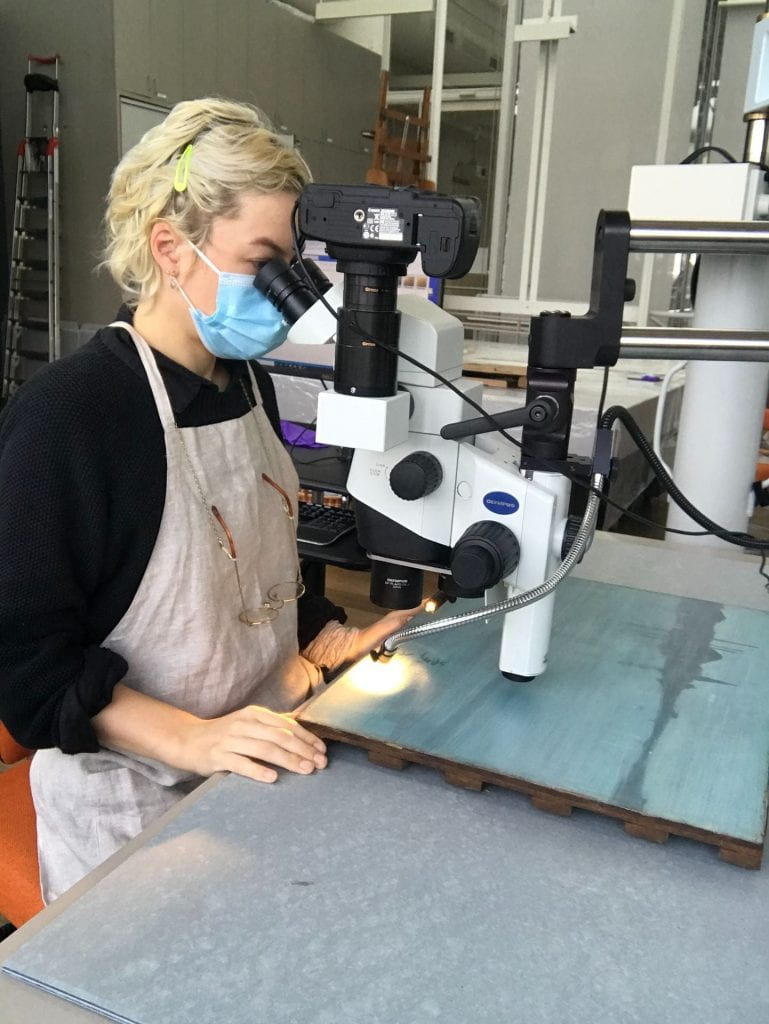
Paintings Conservation Fellowship at Harvard Art Museums
After completing a Masters of Cultural Materials Conservation at the University of Melbourne, Ruby Awburn spent two years in the United States as the Richard I Shader Fellow in Paintings Conservation at the Straus Centre for Conservation and Technical Studies at Harvard Art Museums. Ruby recently returned to Australia to take up a new role at Queensland Art Gallery & Gallery of Modern Art (QAGOMA). In this interview with Samantha Rogers, Ruby reflects on their conservation training, their success in gaining an international fellowship and the progression of their conservation career.
What sparked your interest in becoming a conservator?
Art galleries and museums have always sparked joy for me. Some of my earliest memories are of going to the National Gallery of Victoria and looking at a Streeton or McCubbin with my parents. I grew up with a close family friend who was a paper conservator. She suggested I consider conservation when I was deciding what subjects I wanted to take in high school; I found it difficult to choose between the humanities and science (so I didn’t!).
What made you decide to specialise in the conservation of paintings?
I fell in love with paintings conservation after watching a documentary on the Louvre in high school and that became my goal. Modern and contemporary paintings are the artworks that I seek out and am naturally drawn to when I visit a gallery or museum. It seemed like an obvious fit. I also wanted to be in an emerging field of conservation, and modern paintings and their materials provide different condition issues and deterioration mechanisms that are still being researched and understood. There’s a lot of creative problem-solving in this line of work, which is really rewarding.
You completed your Masters of Cultural Materials Conservation at the Grimwade Centre at The University of Melbourne. Can you tell us a little about your experience there?
I studied at the Grimwade Centre in 2015–2016. The most valuable experience I had was the internship subject, when I organised to go to QAGOMA, and my research thesis. I also used the extracurricular opportunities that were offered, such as volunteering with the Koorie Heritage Trust, to gain further hands-on industry experience.

How do you feel that this course set you up for working internationally?
The internship opportunity was invaluable, as was the opportunity to write a research thesis. This provided me with the ability to conduct research and problem solve when in the workplace. The intensive model also provided the foundational understanding of materials and ethics that I could build on later.
Can you explain the process of applying for the Richard I Shader Fellowship that enabled you to begin your work at the Straus Centre?
I applied for the fellowship at the Straus Centre twice. International fellowships are highly competitive, as the American conservation training programs have a yearlong internship as part of their degree to prepare students to apply for fellowships as the next step if they want to work within art institutions. I received feedback from my initial application that I needed more experience to be considered.
Over the next two years I worked for the Grimwade Commercial Services one or two days a week; published a paper from my thesis research; acted as a consultant for the conservators at QAGOMA on a research project into contemporary canvases and their priming materials; worked as a private conservator for various auction houses and clients; and completed a three-month internship at the Museum of Modern Art (MoMA) in New York.
Applying a second time for the Straus fellowship, I received an interview and was ultimately successful. One thing I would advise emerging graduate conservators is to continue to push yourself, gain experience (no matter how small) and keep applying for these positions. Your perseverance, hard work and passion will pay off.
What was your most memorable experience working at Harvard Art Museums?
Honestly, it was the relationships I made. The conservators at the Straus Centre are phenomenal mentors. The artwork we were treating and that were passing through the labs were second to none. Walking into the space and having a Tintoretto on the table and a Degas or Gauguin on an easel was surreal. To be able to see and participate with my colleagues working on these paintings was a singular experience.
The research I completed during my fellowship allowed me to form a deep intimacy with a painting by a modern artist, Kumi Sugaï [1919–1996]. Not only was I able to develop a treatment to revive a painting that couldn’t be displayed due to its condition, I was able to undertake archival research regarding the painting’s acquisition history and analyse exhibition trends at the Harvard Art Museums to contextualise the historic neglect of the painting, both physical and art historical. Challenging art historical thinking and systemic curatorial practices that have led to the continued centring of ‘global’ modernism on Europe and America is an important avenue of consideration and something that conservators are currently calling into question and becoming more involved with.

How has the fellowship helped you develop in your conservation practice?
The paintings conservation fellowship at the Straus has been foundational in developing confidence in my problem-solving abilities and practical skills. The support, guidance and opportunities for research were invaluable. I couldn’t recommend this experience enough to emerging conservators.
You have now returned to Australia to work at the Queensland Gallery of Modern Art. What are you looking forward to about this next step in your career?
Coming back to QAGOMA after five years of developing my practice feels like completing a cycle. I am looking forward to contributing to the gallery and conservation team that has been instrumental in my development. I am also looking forward to working more closely with their significant Australian and Asia Pacific collections.
